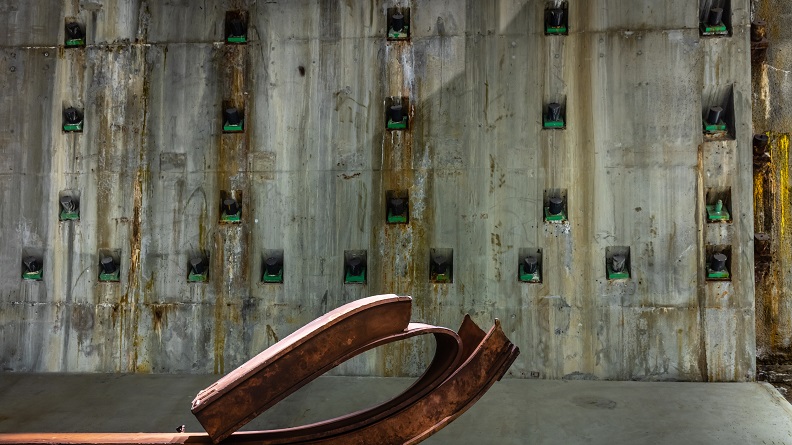Looking Back on 100 Years of Port Authority History through the 9/11 Memorial Museum Collection
Looking Back on 100 Years of Port Authority History through the 9/11 Memorial Museum Collection
Celebrating its centennial anniversary this month, the Port Authority of New York and New Jersey is the agency responsible for the construction, maintenance, and oversight of some of the most complex transportation and infrastructure in the country. Visitors to the 9/11 Memorial & Museum have long made use of Port Authority–managed transportation to reach the site, including the PATH train between New York City and New Jersey, John F. Kennedy International Airport, Newark Liberty International Airport, and the Oculus, a transportation hub located adjacent to the Memorial. The Port Authority also oversees the entire 16-acre World Trade Center (eight acres of which are occupied by the Memorial and the Museum), including One World Trade Center. As a result, the visitor experience at the 9/11 Memorial & Museum is closely tied to the experience of the World Trade Center as a whole and all of its offerings—One World Observatory, public art installations, Liberty Park, and more.
Artifacts in the Museum’s collection help to convey the agency’s storied history, from the construction of the World Trade Center to the civilians and first responders who showed courage and selflessness on September 11, 2001, to the Port Authority's continued partnership with the 9/11 Memorial & Museum.
Early Construction of the World Trade Center
The World Trade Center, including the Twin Towers, required more than a decade of planning and seven years of construction before it was officially dedicated on April 4, 1973. In the 9/11 Memorial Museum, visitors can view the stainless steel dedication pedestal that stood on the World Trade Center plaza, as they journey from Concourse Lobby down to bedrock level.
Overseen by Guy Tozzoli, director of the World Trade department for the then–Port of New York Authority, the construction of the World Trade Center employed new, innovative techniques. One of the most revolutionary construction elements was the Italian-patented slurry wall method. Used in the 1950s to construct Milan’s subway system, this method required an underground perimeter wall to prevent water from entering the excavation site. As the World Trade Center was being constructed on a 16-acre landfill known as Radio Row, the construction of the slurry wall blocked the Hudson River from the site and allowed for excavation to bedrock, which would become the foundation for the Twin Towers. Today, the reinforced slurry wall still stands and serves as the centerpiece of the Museum’s Foundation Hall.

The World Trade Center Experience and Culturally Iconic Twin Towers
Following the dedication in 1973, the World Trade Center swiftly lived up to its name, assuming its role as a place of global commerce and tourist attraction. The Twin Towers made their mark on the New York City skyline and would become a cultural mainstay over the next several decades.
Designed by architect Minoru Yamasaki, the Twin Towers were each 110 stories and provided a combined 10 million square feet of office space. Attracting tens of thousands of people each day, they were the tallest buildings in New York City and briefly the tallest in the world.

Besides the novelty of their sheer size, the Twin Towers offered a variety of experiences to visitors from around the world. The World Trade Center Observation Deck, located in the South Tower, provided uninhibited views of New York City and New Jersey over 1,300 feet in the air. In 1976, the highly anticipated North Tower restaurant Windows on the World opened and offered guests an opportunity to dine among the clouds.
From the 1970s to 2001, the Twin Towers were fully embraced by popular culture, their image appearing regularly in films and television shows. It was their status as a cultural icon and a symbol of capitalist strength that contributed to their targeting by terrorists, even before 9/11.
The 1993 World Trade Center Bombing and the Port Authority Move Back Team
On February 26, 1993, at 12:18 p.m., a small cell of terrorists, with links to a local radical mosque and broader Islamist terror networks, detonated approximately 1,200 pounds of explosives in a rental van in the underground parking garage at the World Trade Center. The bombing killed six people, including four Port Authority employees, and left more than 1,000 injured.
During the evacuation of the towers, some Port Authority staff members with specialized knowledge of the buildings stayed behind to assist people in making it to safety. Following the attack, the Port Authority Move Back Team worked around the clock to reopen the World Trade Center complex in March, welcoming tenants back with small tokens of appreciation.
The bombing prompted a massive security upgrade in the buildings, led by longtime Port Authority employee Douglas Gene Karpiloff, who would later lose his life helping to evacuate the towers on 9/11. Many of the enhanced security measures and regular evacuation and fire drills were credited with saving thousands of lives eight years later when the Twin Towers were targeted again.
The September 11, 2001 Attacks
Like several agencies and companies who operated at the World Trade Center, the Port Authority experienced a devastating loss of personnel on 9/11. Eighty-four Port Authority employees, including 37 members of the Port Authority Police Department, were killed in the attacks.
Since the attacks, countless stories have emerged of bravery and selflessness demonstrated that day by Port Authority employees. After leaving her career as a nurse and joining the PAPD in 1987, Kathy N. Mazza was the first female commanding officer of the department’s police academy. She responded to the World Trade Center and was helping to evacuate the North Tower at the time of its collapse.
On the 69th floor of the North Tower, Port Authority accountant John Abruzzo relied on the selflessness of his colleagues to evacuate the building safely. Abruzzo, who suffered from quadriplegia, relied on a power wheelchair for mobility. Due to improvements in fire safety and evacuation procedures at the World Trade Center after the 1993 bombing, Abruzzo had the use of a special evacuation chair on 9/11. Several of his coworkers, including dual World Trade Center survivor Philip Caffrey, took turns carrying Abruzzo down 69 flights, making it out of the building only a few minutes before it collapsed.
The fortitude and courage demonstrated by civilian and first responder Port Authority employees alike saved lives on 9/11 and continue to provide inspiration to this day.

The Revitalization of the World Trade Center
In its 100-year history, the Port Authority of New York and New Jersey has helmed projects of revolutionary magnitude and continues to lead the revival of lower Manhattan after the 9/11 attacks. Nearly 20 years ago, Ground Zero was covered in millions of tons of debris. Today, the 9/11 Memorial & Museum stands as a testament to that history, but it is surrounded by skyscrapers, transportation hubs, and a forthcoming performing arts center that all signal a return to prosperity in lower Manhattan. Under the oversight of the Port Authority, the World Trade Center will undoubtedly remain a symbol of resilience and innovation.
By 9/11 Memorial Staff
Previous Post
This Arbor Day, We Celebrate the More Than 400 Trees on the Memorial Plaza

Learn about the importance of trees to the sustainable design of the 9/11 Memorial plaza.
Next Post
Marking the 10th Anniversary of the Osama bin Laden Raid

This past weekend marked the 10-year anniversary of Operation Neptune Spear, the raid on Osama bin Laden’s compound in Abbottabad, Pakistan, that resulted in his death. In recognition of the anniversary, we are highlighting an artifact currently on view in the special exhibition Revealed: The Hunt for Bin Laden that tells the story of the nearly decade-long search for the mastermind of the 9/11 attacks.